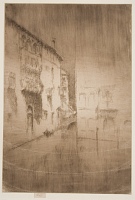Nocturne: Palaces | ||
| Number: | 200 | |
| Date: | 1879/1880 | |
| Medium: | etching and drypoint | |
| Size: | 298 x 202 mm | |
| Signed: | butterfly at lower left (12) | |
| Inscribed: | no | |
| Set/Publication: | 'Second Venice Set', 1886 | |
| No. of States: | 12 | |
| Known impressions: | 54 | |
| Catalogues: | K.202; M.199; W.168 | |
| Impressions taken from this plate (54) | ||
TECHNIQUE
Like the majority of Whistler's Venice plates, Nocturne: Palaces was begun primarily in etching, with drypoint added as the copper plate was developed. The first known state, which is almost completely etched, has light cancellation marks on and in front of the right palace, perhaps indicating the artist's dissatisfaction with the plate at that early stage. Any such discontent was short-lived, however, as impressions of the next states bear pencil butterfly signatures that date from 1880/1881 (i.e. ), not long after the first proof was pulled. 10
10: The first known proof was signed ca 1885, years after it was printed, perhaps around the time Whistler offered it for sale ().
While Whistler used plate-tone (ink left on the unetched surface of the copper plate) liberally in printing of many his Venice plates, Nocturne: Palaces and Nocturne 222 represent the most complete synthesis of line and tone among his intaglio prints. With the exception of the first known proof of Nocturne: Palaces (), every located impression is richly inked and carefully wiped. The underlying lines changed relatively little during the course of the twelve states, mostly amounting to increased or renewed shading, and Whistler used the incised lines as a framework for his painterly method of inking and wiping, making each impression unique in its combination of ink colour, paper colour and manipulated platetone. 11
11: For a discussion of Whistler's 'monotype' printing and the influence of Otto Bacher and others, see Lochnan 1984[more], pp. 196-211.
In a number of cases, the ink was so heavily applied to the copper plate (and the process of printing with a hand-press so variable), that defects are apparent in the darkest passages of plate-tone on impressions of Nocturne: Palaces. These irregular areas vary in size but are characterised by disturbances to the plate-tone in the form of tiny dots, showing the colour of the paper where the ink did not adhere. This phenomenon, which occurs in both artistic and commercial printing, is called 'picking', and it is found on other etchings and drypoints by Whistler that were pulled from plates printed with heavy plate-tone. He apparently did not consider areas of picking to be defects, as he signed and sold many impressions of his etchings with both small and large areas of disturbed tone (see , and the discussion in STATES, under State 10).
PRINTING
The first proof was printed in black ink on ivory laid paper with a Strasbourg Lily/'VGZ' watermark (); several later impressions also bear variations of the Strasbourg Lily watermark, with 'FI' () and 'WR' (). Both a second and ninth state were printed on off-white laid paper with a hunting horn and 'LVG' watermark (, ). Other later impressions, printed in dark brown ink on laid paper, have various water- or countermarks including 'WW' (, ), Pro Patria (); 'BR' () and 'DHK' (). A few late impressions are on Asian papers including Asian laid (, , ).
Nocturne: Palace was published by Messrs Dowdeswell and Thibaudeau with the Twenty-six Etchings or the 'Second Venice Set' in 1886. A record of impressions for this edition lists sixteen delivered on 22 July, one on 20 August, one on 2 April and two on 3 April 1886; three on 17 January and five on 27 January, and twenty-one - which were probably of the final three states - on 8 February 1887, a total of 49. 12
12: Whistler to W. Dowdeswell, GUW #08717.
The plate was then cancelled lightly, and at least one richly inked impression was printed, trimmed and signed to show that the edition was complete. It was then cancelled more heavily, and two more impressions printed, one on paper with an 'IV' countermark (); and the other, with a Marlowe watermark ().
Most of the impressions are trimmed to the platemark and signed on the tab with Whistler's butterfly and 'imp.' to show that he printed it (or he approved printing done under his supervision). Some impressions of the early states - including the fourth state () - were signed in pencil with butterflies dating from 1880 and 1881 (with veins on the wings). By the fifth state () it had metamorphosed and by the sixth spread its mature wings (). In other words, the fifth to twelfth states were printed and signed from 1886-1887.
